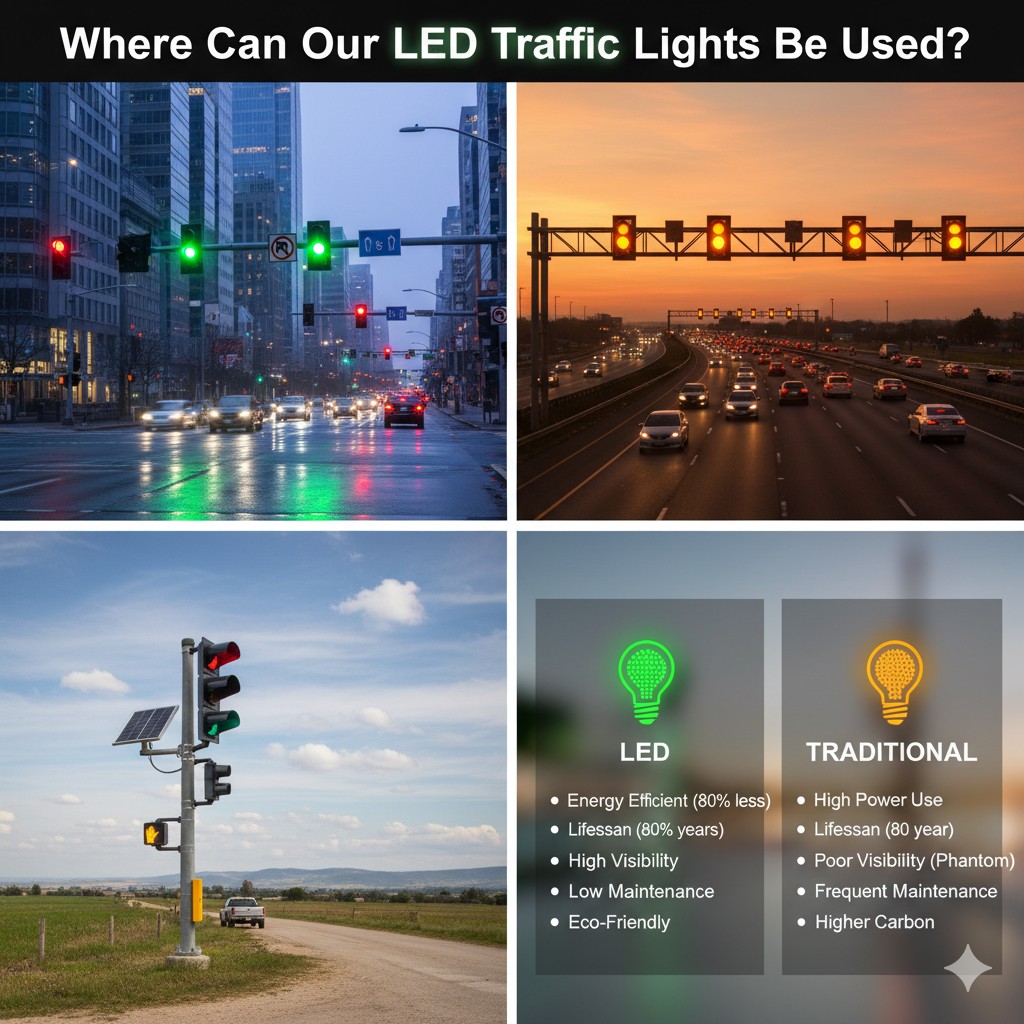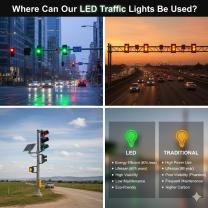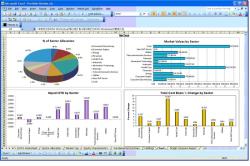Where can our LED traffic lights be used?
The landscape of modern traffic management is undergoing a significant transformation, driven by the adoption of LED (Light Emitting Diode) technology. Once dominated by power-hungry, short-lived incandescent bulbs, traffic signals are rapidly being upgraded to highly efficient and durable LED modules. This shift is an essential component of creating safer, more cost-effective, and sustainable road networks worldwide.
LED traffic lights offer distinct advantages over traditional lights, primarily in their vastly improved durability, visibility, and remarkable energy efficiency. These benefits make them the ideal solution for virtually any setting, from the most congested metropolitan intersections to the most remote rural crossroads. The following sections will provide a comprehensive overview of the diverse installation locations and use cases for LED traffic signals, demonstrating their versatility and why they are becoming the global standard in intelligent transportation systems.
Where Can LED Traffic Lights Be Installed?
LED traffic lights are not limited to a single type of roadway; their deployment is suitable across the entire spectrum of road infrastructure. The bright, focused light from LEDs ensures maximum effectiveness regardless of the complexity of the intersection or the volume of traffic.
Typical installation sites include:
Major Intersections: At complex, multi-lane junctions, LED traffic lights provide a clearer, more discernible signal, reducing the dangerous phantom effect common with incandescent signals (where sunlight makes an unlit lens appear illuminated).
Pedestrian Crossings: Often paired with countdown timers, LED pedestrian signals offer high visibility, even under direct sunlight, enhancing safety for those on foot.
Roundabouts: While not always requiring full signals, certain high-volume roundabouts or those with heavy pedestrian traffic use LED indicators for lane guidance or yield control.
School Zones: Flashing LED beacons and school zone speed limit signs use the technology to maximise visibility, ensuring drivers are alerted to reduced speed limits and potential pedestrian presence.
LED lights’ compatibility is a major selling point, as the signal modules are designed to integrate seamlessly into existing traffic control infrastructure and signal housings. This allows municipalities to upgrade in phases without completely overhauling their entire system, benefiting both high-traffic urban corridors that demand constant reliability and low-traffic roads where reduced maintenance is key.
Are LED Traffic Lights Suitable for Highways?
Absolutely, LED traffic lights are highly suitable for highways and provide critical safety and operational benefits, particularly at high speeds.
On highways, the key to safety is enhanced brightness and long-range visibility. LED signals deliver a focused, intense light that is easier to spot from a greater distance, which is crucial for drivers traveling at high speeds who require maximum reaction time. Their performance is superior in all weather conditions, cutting through fog, heavy rain, and snow more effectively than older lights.
The safety advantages translate directly into:
Better Response Times: Drivers have more time to register the signal change, leading to a reduced likelihood of rear-end collisions.
Safety Corridors: They are used in dynamic message signs and lane control signals, providing real-time information to manage traffic flow during incidents or congestion.
Examples of LED usage in highway infrastructure include:
On-Ramps and Metering: LED ramp meters control the flow of traffic entering a highway, using their instantaneous on/off capability for precise timing.
Toll Booths and Plazas: Clear LED lane indicators direct vehicles to the correct payment or express lanes.
Emergency and Reversible Lanes: Highly visible LED overhead signals clearly mark which lanes are open or closed, managing peak traffic flow and emergency access.
Can LED Traffic Lights Be Used in Rural Areas?
LED traffic lights are arguably even more ideal for deployment in rural and remote areas than they are for cities, specifically because of the unique challenges these environments present.
Rural challenges often include:
Limited Electricity Supply: Access to the main power grid can be costly or non-existent.
Fewer Maintenance Teams: Long distances between intersections mean maintenance response times are slower, and labor costs are higher.
The inherent properties of LEDs address these issues directly. Their low energy consumption—up to 80% less than incandescent bulbs—makes them extremely economical to run. Furthermore, their long lifespan (often 5 to 6 years or more, even under harsh outdoor conditions) drastically reduces the frequency of maintenance visits, leading to significant savings for local authorities.
A powerful and sustainable option for off-grid or remote rural locations is the solar-powered LED traffic signal. These systems combine the low-power draw of LEDs with solar panels and battery storage, allowing the signals to operate reliably with zero energy costs and complete independence from the main electrical grid. This makes it possible to install necessary traffic control devices in areas that would have been cost-prohibitive with traditional technology.
How Are LED Traffic Lights Applied in Smart Cities?
In a Smart City, LED traffic lights evolve from simple signaling devices into critical sensors and nodes within an intelligent transportation network. They are foundational to the future of urban mobility.
This is achieved through the integration with smart traffic management systems, leveraging IoT (Internet of Things), AI (Artificial Intelligence), and sensors (like inductive loops, video, and radar). The LED signal head itself becomes a platform for embedded technology.
Key applications in smart cities include:
Adaptive Lighting and Timing: The most impactful application is the use of adaptive lighting. Unlike fixed-schedule lights, these systems use real-time data from sensors and cameras to adjust signal timing based on real-time traffic flow, vehicle presence, and pedestrian demand. For instance, an intersection might extend the green light for a heavy corridor to clear congestion or shorten a phase when no vehicles are detected.
Vehicle-to-Infrastructure (V2I) Communication: Future-ready LED traffic lights can communicate wirelessly with equipped vehicles, sharing signal timing information to assist autonomous and connected cars in optimizing speed and reducing sudden braking.
Pilot Programs: Cities worldwide, like Los Angeles (ATSAC system) and various European and Asian metropolises, have implemented smart intersection pilots with LED lights, consistently demonstrating a reduction in travel time, a decrease in vehicle emissions, and an overall improvement in safety and traffic flow.
What Are the Advantages of Using LED Traffic Lights?
The widespread adoption of LED traffic lights is due to a compelling combination of economic, environmental, and safety advantages over traditional incandescent systems.
| Feature | LED Traffic Lights | Traditional Incandescent |
| Energy Consumption | Up to 80% less power consumption | Very high |
| Lifespan | 50,000–100,000 hours (5–10 years) | ~1,000–8,000 hours |
| Visibility/Clarity | High brightness, focused, virtually eliminates "phantom light" | Lower brightness, susceptible to "phantom light" effect from sun glare |
| Maintenance | Significantly reduced maintenance costs due to long life | High due to frequent bulb replacement |
| Eco-Friendliness | Lower carbon footprint, no mercury | Higher carbon footprint, some contain toxic materials (fluorescents) |
Key Benefits
Energy Efficiency: The primary economic driver. LEDs save a massive amount of power, allowing municipalities to redirect savings toward other infrastructure projects.
Longer Service Life: The solid-state nature of LEDs means they last up to ten times longer than traditional bulbs, leading to dramatically reduced maintenance costs for municipalities in terms of labor and replacement parts.
Superior Visibility: Their brighter, more uniform light output ensures better visibility in adverse weather (fog, rain, snow) and at night, directly contributing to increased road safety.
Reliability: LED signals are highly resistant to shock and vibration and perform reliably across a wide range of temperatures, from extreme cold to intense heat.
FAQ Section
How long do LED traffic lights last?
LED traffic light modules have a significantly longer lifespan than traditional bulbs, typically lasting between 5 and 10 years (50,000 to 100,000 hours) before replacement is required, depending on environmental factors and operating conditions.
Do LED traffic lights work during power outages?
Yes, they can. Due to their extremely low power draw, LED traffic light systems are often integrated with a battery backup system (Uninterruptible Power Supply or UPS) that allows them to continue operating for several hours, or even a full day, during a power outage.
Can LED traffic lights be solar-powered?
Absolutely. The low energy consumption of LED traffic lights makes them perfectly suited for solar-powered installations, especially in rural or remote areas where connecting to the electrical grid is difficult or costly. The solar panels recharge a battery bank that powers the lights.
Are LED traffic lights approved by international road authorities?
Yes, they are the widely accepted standard. LED traffic lights must comply with strict national and international standards set by authorities such as the ITE (Institute of Transportation Engineers) in North America and various European and global standards bodies, ensuring safety, consistent color, and minimum light output requirements are met.
Conclusion
The versatility of LED traffic lights makes them an unparalleled choice for modernizing road networks across the globe. From navigating the dense, complex congestion of smart city traffic lights to providing reliable, low-maintenance control on LED traffic lights in rural areas, and ensuring high-speed safety with LED traffic lights for highways, their application is nearly universal.
The advantages are clear and profound: massive energy savings, drastically reduced maintenance, superior visibility, and a smaller environmental footprint. LED traffic lights installation is not just an upgrade; it’s an investment in a safer, more efficient, and sustainable future for transportation. Stakeholders—from municipal planners and rural authorities to highway agencies—are strongly encouraged to prioritize upgrading to LED systems to fully realize the cost savings and safety improvements this foundational technology provides.













SmartCityPlanner
on October 03, 2025This article perfectly captures why the transition to **LED traffic lights** is non-negotiable for modern infrastructure. The points on **adaptive lighting** and V2I integration in smart cities are spot on. The efficiency savings alone are massive, but the real value is in the enhanced safety and reduced congestion.